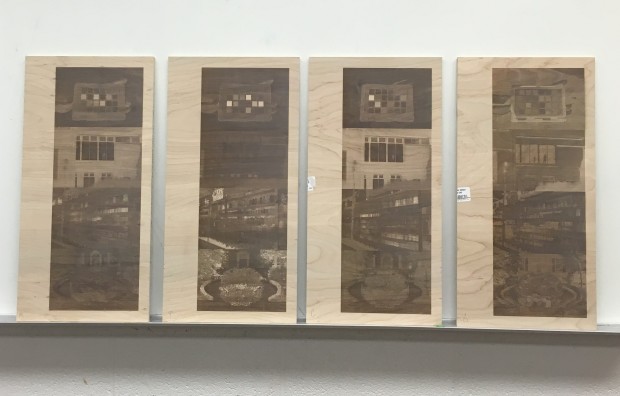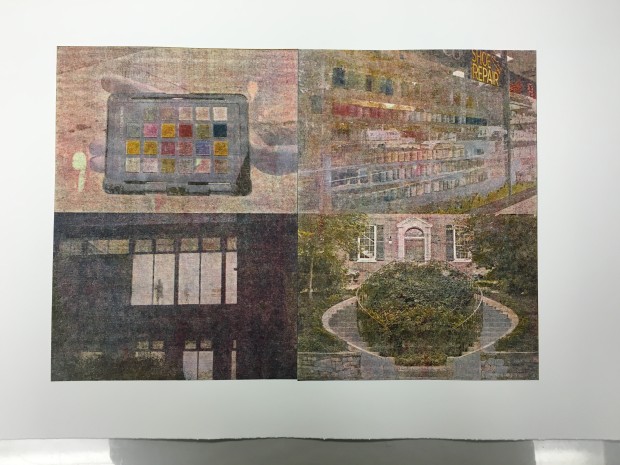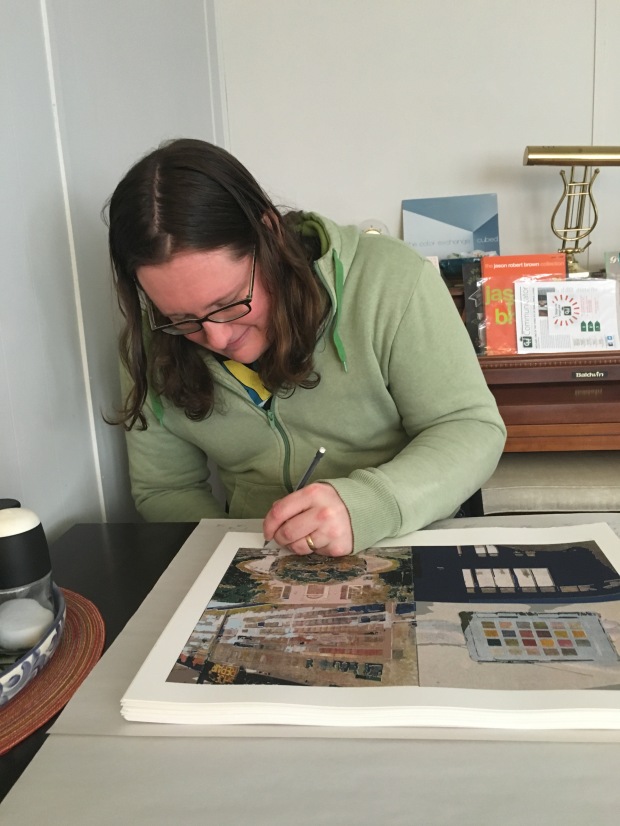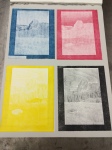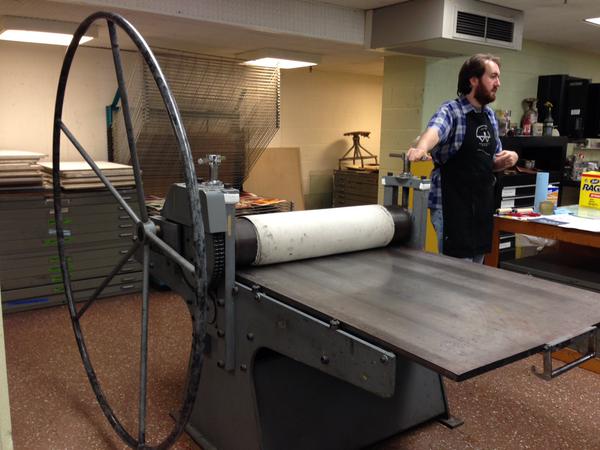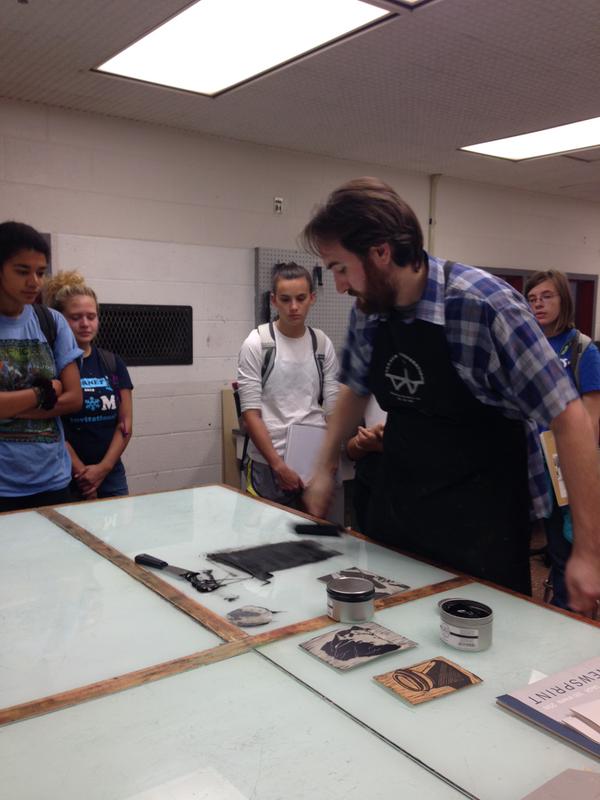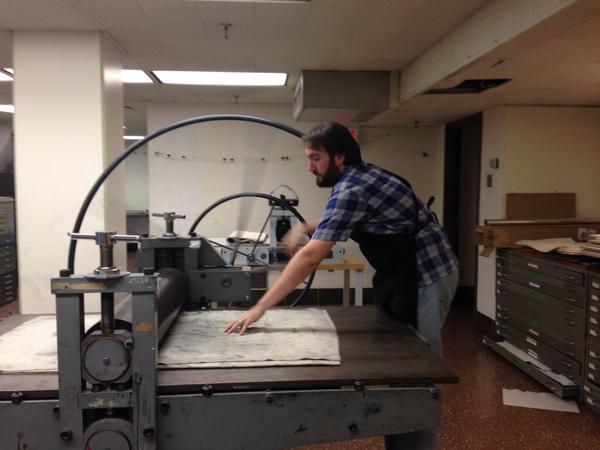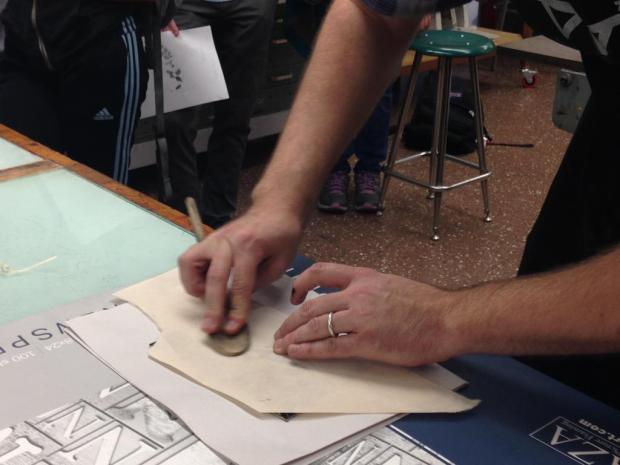And again, I bring you two more prints from the Intersecting Methods portfolio. Today, we reveal the editions of Amze Emmons and Jon Goebel. Click here for Amze’s bio post and click here for Jon’s.
Here is Amze’s statement about his print.
“What It Provides or Furnishes/What it offers the Animal,” Screenprint, 18”x14” or 14”x18”, 2016
In their first collaboration, Dr. Jeremy Teissére and Amze Emmons delved into body- and subject-centered definitions of consciousness and perception. Emerging from close readings of two texts, Anecdote of the Jar by the poet Wallace Stevens and Theory of Affordances, a chapter excerpted from James J. Gibson’s The Ecological Approach to Visual Perception, the work captures the ‘aliveness of objects’ for the body. Together they are interested in how objects act as silent symbols to guide the behavior of the body and orient one in a landscape. Gibson’s interest in a more gestalt and direct philosophy of perception led to his coinage of ‘affordances’, or the properties of an object that implicitly tell a body how to use that object. Thus, door handles, buttons, switches, cups, hammers, pencils, spoons have affordances that guide our actions and shape the many thousand unconscious micro-movements that we make to use them. Likewise, in Stevens’ Anecdote of the Jar, objects loom larger than life, animated seemingly from their own ‘consciousness’ that we afford them, and in so doing, allow them to control and manipulate our movements through the worlds they co-construct. Working from these documents our collaborators spent a great deal of time excitedly talking, drinking coffee, and making incomprehensible flow charts.
Since this was Teissére’s first printmaking collaboration, and Emmons’ first attempt to visualize a conversation on the nature of perception, the pair adopted several constraints to inform a non-linear call-and-response model of making the print. First, they wanted a print that would also model the ideas they were attempting to visualize. Second, they would work from several closed sets of source material. And lastly, in printing they would leverage color and transparency in an intuitive method for combining visual information.
What It Provides or Furnishes
One side of the print depicts a ‘landscape’ of appropriated scientific illustrations of protein structures loosely drawn from Teissére’s laboratory research mapping the allopregnanolone (ALLO) and benzodiazepine binding sites on the gamma-aminobutyric acid Type A receptor (GABAA R). This landscape is populated with pop-up buttons from children’s toys, labeled with text taken from Gibson’s writing on affordances. The landscape is a zany visualization of the ecological approach to perception with the component proteins of our brain’s neural network literally defining the nature of the environment, punctuated by annotated affordances.
What it offers the Animal
Another side of the print, a composite portrait looks out. Underlying is a participant in a Ganzfeld-effect experiment, in which a person’s eyes and ears are covered to block sensory stimulus. Famously, in this experiment, the brain thus deprived of external sights and sounds, begins fabricating and filling in virtual sensory experience from the neural noise of perceptory absence. Overlaid is another kind of portrait, a map of eye movements tracking a human face from an experiment by the Russian psychologist Alfred Yarbus in the early 20th century. Out of the head explode electroencephalogram (EEG) traces taken from Teissére’s experiments in sensory perception, constructed into 3D paper models, and then photographed.
By making a two sided print, the collaborators present the audience with a binary affordance (recto/verso) in two sorts of objects, a landscape and a portrait, requiring a decision and an interaction.
-

-
What It Provides or Furnishes by Amze Emmons and his collaborator, Jeremy Teissére
-

-
Detail of What It Provides or Furnishes
-

-
What it offers the Animal by Amze Emmons and his collaborator, Jeremy Teissére
-

-
Detail of What it offers the Animal
Jon wrote this statement for his print.
“Ephemeral Horizon,” Laser cut Plexiglas with hand engraved work, Printing: Relief, monotype, and intaglio, 18”x14”, 2016
This project was in collaboration with Dr. Neil Scott of the Makery (Hilo, HI). The initial project was to cut duplicate designs from multiple thicknesses of Plexiglas to create various levels suitable for color viscosity printing. The proofs were interesting, but not on par with my vision. I decided to engrave some of the pieces. The circles were stood on by myself and I spun around on one foot to create the drypoint texture on the pieces. They were additionally attached to a rotating base and engraved to get additional depth. Other pieces were inked like a monotype print, others relief rolled, and some wiped intaglio. There were many variations in this proofing process, but I am happy with the final color scheme.
The title “Ephemeral Horizons” is purposefully ambiguous. The piece is inspired by Hawaiian landscape and the sky and embraces the notion that our thoughts, dreams, life, and the universe are all momentary things.
-

-
Ephemeral Horizon by Jon Goebel and his collaborator, Neil Scott
-

-
Detail of Ephemeral Horizon
Next week will be the SGC International conference in Portland, OR. I will be there for one of the open portfolio sessions with all the prints from the Intersecting Methods 2014 and 2016 portfolio and some personal work. I will post in Instagram, Facebook, etc the session and location of my table when I receive that information this Wednesday.
Check in again next Sunday for two more prints.








